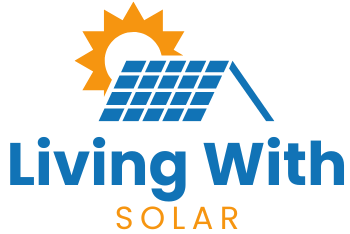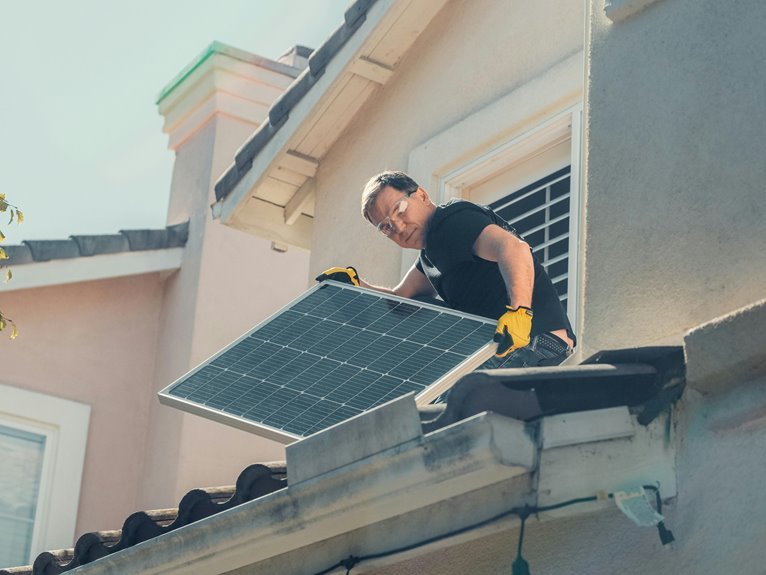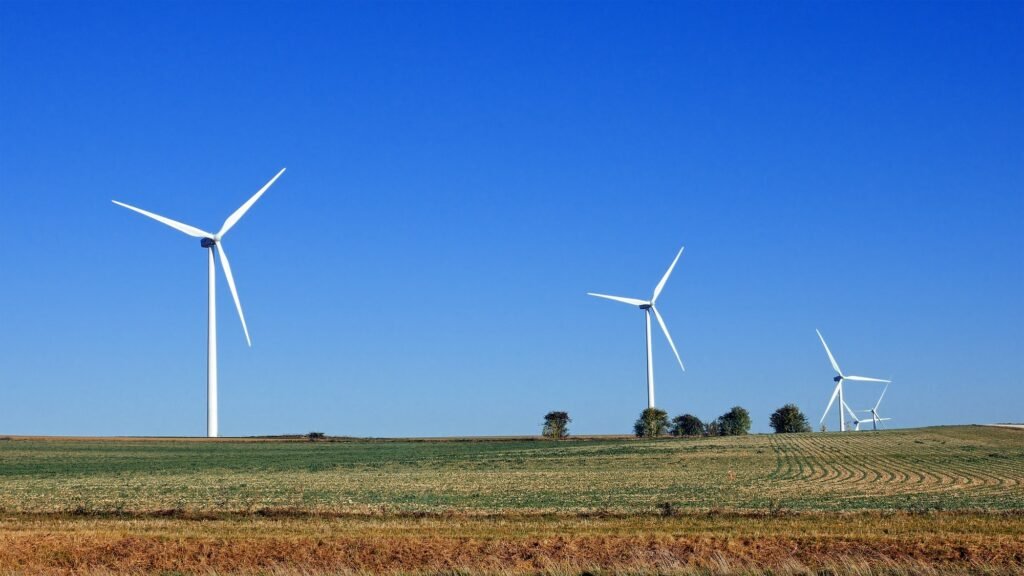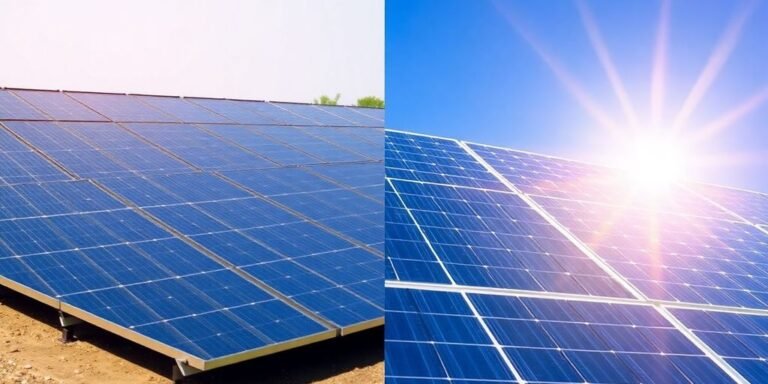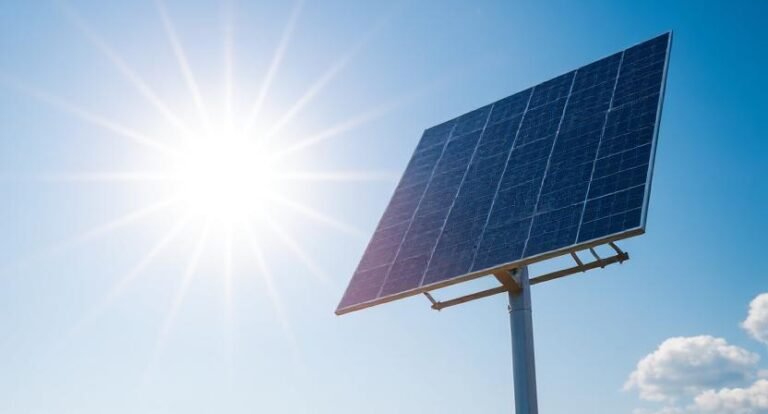Thinking about making the switch to solar energy? It’s a big step, but it’s not as tough as you might think. Solar panels can cut down your electricity bills and help the planet at the same time.
This guide covers everything you need. It starts with picking the right system and ends with getting it up and running.
Whether you’re a DIY enthusiast or prefer hiring a pro, we’ve got tips to help you out.
Let’s dive into the world of solar panel installation and see how you can start harnessing the power of the sun.
Key Takeaways
- Solar panels can significantly reduce your electricity bills and carbon footprint.
- It’s important to assess your roof’s suitability and sunlight exposure before installation.
- There are different types of solar systems, like grid-tied and off-grid, each with its pros and cons.
- Understanding the costs and exploring financing options can make solar more affordable.
- Proper maintenance is key to ensuring your solar panels operate efficiently over time.
Understanding Solar Panel Installation Basics

What Are Solar Panels?
Solar panels are devices that convert sunlight into electricity. They’re made up of many solar cells, which are usually made from silicon.
Sunlight hits these cells and creates an electric field. This makes electricity flow.
This process is called the photovoltaic effect. Solar panels are often installed on rooftops or open spaces where they can get the most sunlight.
How do solar panels work?
The way solar panels work is pretty fascinating. When sunlight strikes the solar cells, it knocks electrons loose from their atoms. As these electrons move, they generate electricity. This electricity can be used immediately or stored in batteries for later use.
Solar panels connect to an inverter. This inverter changes the direct current (DC) from the panels into alternating current (AC). The AC then powers our homes.
Benefits of Solar Panel Installation
There are several reasons to consider installing solar panels:
- Energy Savings: By generating your own electricity, you can significantly reduce your utility bills.
- Environmental Impact: Solar panels reduce reliance on fossil fuels, cutting down on greenhouse gas emissions.
- Increase in Home Value: Homes with solar installations often see an increase in property value.
Installing solar panels is a step towards a sustainable future. It’s not just about saving money; it’s about doing our part for the planet. By harnessing the power of the sun, we can reduce our carbon footprint and promote renewable energy.
A good solar company can help you make this transition. They will guide you through the process and ensure a smooth, efficient installation.
Evaluating Your Home’s Solar Potential
Assessing Roof Suitability
At first, I didn’t think about how important my roof’s condition would be for solar panels. A strong, stable roof is key to supporting the weight of the panels and ensuring they last for decades.
First, check if your roof is in good shape. If it’s old or damaged, consider repairs or even replacement.
Also, think about the roof’s angle and orientation. A south-facing roof is ideal for capturing sunlight. It should have a slope of 15 to 40 degrees.
Understanding Sunlight Exposure
The sunlight your home gets plays a big role in whether solar panels are right for you. I found that using tools like solar evaluations can really help.
They show how much energy your home could potentially generate. These evaluations use easy rating systems. They help you see your home’s solar potential.
Want to know how much sunlight your roof gets? Check out this tutorial. It shows you how to use ArcGIS Pro to assess solar radiation.
Calculating Energy Needs
Before installing solar panels, you should check your household’s energy use. I started by looking at my utility bills over the past year to get an average monthly usage.
Knowing your energy needs helps in choosing the right size and type of solar system. You might also want to conduct an energy audit to spot areas where your home is losing energy.
This can make your home more efficient and help you get the most out of your solar panels.
Taking the time to evaluate your home’s solar potential can lead to significant savings and a more efficient solar energy system. By understanding your roof’s suitability, sunlight exposure, and energy needs, you’ll be well on your way to making an informed decision about going solar.
Choosing the Right Solar Panel System

Types of Solar Panel Systems
When it comes to solar panel systems, there are a few types to consider. Monocrystalline panels are known for their high efficiency but can be pricier.
Polycrystalline panels are cheaper. Thin-film panels are flexible, but they usually last less time.
Each type has its pros and cons, so it’s important to weigh these against your specific needs and budget.
Grid-Tied vs. Off-Grid Systems
Deciding between a grid-tied and an off-grid system is a big step. A grid-tied system links to the local utility grid.
This setup allows you to sell extra power back using net metering. It’s perfect for anyone looking to cut their electricity costs. You won’t have to stress about battery storage either.
Off-grid systems are fully independent of the utility grid. They use batteries to store energy.
This option is great for energy independence. However, remember that the upfront costs can be higher because of battery expenses.
Selecting the Right Inverter
Choosing the right inverter is crucial for your solar panel system. Inverters change the DC electricity from your panels into AC electricity. Your home can then use this AC electricity. There are two main types: string inverters and microinverters.
String inverters cost less and are simpler to install. However, if one panel doesn’t perform,
Microinverters are pricier, but they let each panel work alone. This boosts your system’s efficiency. Consider your budget and efficiency needs when making your choice.
Picking the right solar panel system is like choosing the right tool for a job. Each type of panel and system configuration has its unique benefits, and the best choice depends on your specific energy goals and budget constraints. Take your time to explore the options and consult with professionals if needed.
Navigating Solar Panel Installation Costs
Understanding Installation Costs
When diving into solar panel installation, the first thing that hits you is the price tag. It’s not a small investment, and several factors play into the final cost. A solar panel system for a typical home costs about $18,000 on average.
But this price can range from $10,000 to $30,000. The cost varies based on your home’s location, system size, and panel type.
One of the main elements affecting the cost is the wattage of the system, often priced at about $3 per watt.
Here’s a quick breakdown of the factors influencing costs:
- System Size: Larger systems generate more power but cost more upfront.
- Location: Installation costs can vary by state and local regulations.
- Panel Type: High-efficiency panels might cost more, but they can save you money in the long run.
Exploring Financing Options
Paying for solar panels all at once might not be feasible for everyone. Luckily, there are several ways to finance your solar journey.
One popular option is a solar loan, which works much like a home improvement loan. You borrow the cost of the system and pay it back over time, often with interest.
Leasing is another option. A company puts panels on your roof. You pay a monthly fee to use the energy they produce.
Consider these financing options:
- Solar Loans: Borrow now, pay later. Often, they come with competitive interest rates.
- Leasing: Lower upfront costs, but you will not own the system.
- Power Purchase Agreements (PPAs): Pay for the power you use, not the panels themselves.
Federal and state incentives
The good news is that there are several incentives to help reduce the cost of solar installation. The federal government offers a tax credit that can cover up to 30% of your installation costs.
This means if you spend $20,000 on a solar system, you could get a $6,000 reduction in your tax bill.
States often offer their own incentives, such as rebates or performance bonuses. These can help lower costs even more.
Investing in solar panels not only helps the environment but also can be financially rewarding with the right incentives in place.
Here’s a quick look at potential savings:
- Federal Tax Credit: 30% off the installation cost.
- State Incentives: Vary by state; can include rebates and tax exemptions.
- Net Metering: Sell excess energy back to the grid to offset costs.
Going solar can feel challenging, but it’s a smart choice for your home and the planet. With the right info and planning, you can make it work. An 11 kW solar panel setup might cost about $20,552 after federal tax credits. You could save between $31,000 and $100,000 over its lifetime.
Preparing for Solar Panel Installation

Obtaining Necessary Permits
Before you can even think about getting those solar panels up, you need to tackle the paperwork.
It might seem tedious, but trust me, it’s crucial. You’ll need to apply for the right permits, which vary depending on your location.
Typically, this involves building and electrical permits. Your installer can usually take care of this. But if you decide to do it yourself, be ready to spend time with local zoning offices.
Skipping this step could mean hefty fines or having to remove your panels altogether.
Hiring a professional installer.
If climbing on your roof with a toolbox sounds scary, hire a pro.
They’ll handle everything from the initial assessment to the final connection. When picking an installer, check for certifications like NABCEP. This ensures you get someone who is qualified.
It’s also wise to get many quotes to compare prices and services. A good installer does the job well. They also offer support and maintenance afterward.
DIY Installation Considerations
Feeling adventurous? Installing solar panels yourself can save money, but it’s not for the faint of heart. Here’s what you’ll need to consider:
- Safety First: Always prioritize safety. This means having the right gear, like harnesses and helmets.
- Tools and Materials: Make sure you have all the necessary tools and materials. This typically includes solar panels, inverters, a mounting system, and electrical wiring.
- Time and Effort: Be ready to invest a significant amount of time. It’s not about the installation; you’ll also need to manage permits and inspections.
Installing solar panels isn’t just about going green—it’s about taking control of your energy future. Whether you hire a pro or go DIY, the key is preparation and understanding the process thoroughly.
The Solar Panel Installation Process

Site Assessment and Planning
Before anything else, a thorough site assessment is crucial. An expert will come to your home. They will check the roof’s condition, orientation, and shading. They’ll also check your electrical system to ensure it can handle the new load from the solar panels.
This visit usually takes place right after you sign the contract and set up a site assessment.
The expert will create a detailed plan. This includes the type and number of panels you’ll need, their positions, and the wiring plans.
Installation Day Expectations
Installation day can be exciting, but also a bit chaotic. Your installers will come with all the necessary equipment.
They will start by setting up the racking system that holds your panels. This part is critical as it involves drilling into the roof.
After the racks are securely in place, the panels are mounted, and the wiring begins. Proper wiring is key. It links your panels to the inverter and your home’s electrical system. Depending on the system’s complexity, this process can take a few days.
Post-Installation Checklist
Once the panels are up and running, there are a few more steps to complete. First, you’ll need to schedule a final inspection. A local inspector will come to ensure everything is up to code and safely installed. If everything passes, you can then connect your system to the grid. This means setting up net metering. It lets you sell extra power back to the utility company.
Keep an eye on your system’s performance in the first few weeks. This way, you can make sure everything is working as it should.
Installing solar panels is a significant step towards sustainable living. It’s not just about reducing your carbon footprint but also about taking control of your energy use. Once your system is live, you’ll start seeing the benefits on your utility bill and in your environmental impact. Embrace the change and enjoy the journey to a greener future.
Connecting Your Solar System to the Grid

Understanding Net Metering
Ever wondered what happens to the extra energy your solar panels produce? That’s where net metering comes into play.
It’s a system that credits you for any excess electricity your solar panels send back to the grid.
So, if your panels generate more power than you use, you can watch your utility meter run backward. It’s like a savings account for energy.
Interconnection Agreements
Before you can start sending energy back to the grid, you’ll need to sign an interconnection agreement with your utility company.
This document outlines the terms and conditions for connecting your solar system to the grid. It covers everything from safety standards to liability issues. It’s a bit of paperwork, but it’s essential to ensure everything runs smoothly.
Approval and Inspection Process
Once your solar system is installed, an inspection is next. A local authority will come by to check that everything meets the required standards.
They’ll look at the wiring, the panels, and the overall setup. It might seem like a hassle, but it’s a crucial step to make sure everything is safe and up to code.
Once you pass inspection, you can flip the switch and begin generating your own power.
Having your own solar system isn’t just about saving on bills. It’s also about contributing to a more sustainable future. Each step, from net metering to inspections, ensures that your system is ready to make a positive impact.
Maintaining Your Solar Panel System

Regular Cleaning and Maintenance
Keeping your solar panels clean is actually pretty straightforward. They require little care, but it’s important to keep them clean. Remove dirt, leaves, and bird droppings regularly. Here’s a simple checklist I follow:
- Check for debris: Regularly inspect the panels for anything that might block sunlight. If you spot any, gently clean the panels using a soft brush and mild soap.
- Check for damage: Examine the panels and parts, like wiring and mounts, for wear. Replace anything that looks damaged.
- Inverter check: The inverter is key because it turns the DC power from the panels into AC power for your home. Make sure it’s working correctly and producing the expected power.
Monitoring System Performance
Setting up a monitoring system is a game changer. It helps you keep an eye on your system’s performance and catch any issues early. Here’s how I do it:
- Connect to the internet: Make sure your monitoring system is online to send data to the platform.
- Register your system: Once connected, register with the provider, giving details like panel size and inverter type.
- Set alerts: Most systems let you set alerts for issues like a drop in energy production.
- Regular checks: Keep an eye on the system’s data to spot any performance dips.
Troubleshooting Common Issues
Even with regular maintenance, things can go wrong. Here’s how I tackle common problems:
- Low output: If your system isn’t producing enough power, check for shading or dirt on the panels.
- Faulty inverter: If the inverter isn’t working, it might need a reset or replacement.
- Connection issues: Loose wires can cause trouble. Make sure everything is secure.
Keeping your solar panels in top shape isn’t just about cleaning them occasionally. It’s about ensuring every part of your system is functioning as it should, from the panels themselves to the inverter and beyond. Regular checks and maintenance can keep your system running smoothly for years to come.
Maintaining your solar panels is all about regular checks and addressing issues promptly. This way, you can enjoy the benefits of solar energy without a hitch. A well-maintained system works better and lasts longer. This saves you money over time.
If you want to know more about the benefits of solar energy, consider exploring how to harness it.
Maximizing the Benefits of Solar Energy

Reducing Energy Consumption
When I first installed my solar panels, I learned that having them wasn’t enough. I had to reduce my energy use to really see the savings.
Reducing energy consumption is all about making small changes that add up. I began by replacing traditional bulbs with LEDs. I also unplugged devices when I didn’t use them.
It might seem like a hassle, but these little adjustments can make a big difference. Plus, it feels good knowing I’m doing my part to conserve energy.
Storing Excess Energy
One of the coolest things about solar panels is the ability to store excess energy. Imagine a sunny day where your panels generate more power than you need. Instead of letting it go to waste, you can store it in a battery system.
This stored energy can be a lifesaver during cloudy days or at night. I found it super helpful to have a backup, especially during power outages.
Having a battery storage system is like having a safety net that keeps your home powered no matter what.
Selling Back to the Grid
Selling excess energy back to the grid is another fantastic benefit. I remember the first time I got a credit on my electricity bill; it felt like I had hit the jackpot.
Net metering lets you earn credits for the extra energy your system makes.
It’s a win-win. You cut your energy costs and help the community by providing clean energy. It’s definitely worth looking into if you are considering solar.
Exploring Advanced Solar Technologies

Battery Storage Solutions
Battery storage solutions are one of the most exciting developments in solar energy.
Battery technology has changed how we use solar power. Now, we can store energy for times when the sun isn’t shining.
This means you can keep your home powered during the night or on cloudy days. You have several choices. Lithium-ion batteries are a popular option. They are known for being efficient and lasting a long time.
They might be a bit pricey, but they can save money in the long run by reducing reliance on the grid.
Smart Home Integration
Using solar panels with smart home systems is a growing trend. Imagine controlling your energy usage directly from your smartphone or through voice commands.
Smart inverters and energy management systems help you use solar energy better. They automatically adjust to fit your household’s needs.
This boosts convenience and maximizes efficiency. You’ll get the most from your solar investment.
Future Trends in Solar Technology
Looking ahead, the future of solar technology is bright. Solar panels are getting better. New materials and designs capture more sunlight. They also convert it into electricity more effectively.
Thin-film solar panels are lighter and more flexible. This makes them great for many uses.
There is ongoing research on perovskite solar cells. They promise better efficiency and lower costs.
As technology grows, solar energy will be easier and cheaper for everyone to access.
Embracing advanced solar technologies not only helps reduce your carbon footprint but also prepares your home for a more sustainable future. With ongoing advancements, there has never been a better time to explore what solar energy can do for you.
Understanding the Environmental Impact of Solar Energy

Reducing Carbon Footprint
When I think of solar energy, I first see its power to reduce carbon emissions. Solar power is different from traditional energy sources like coal and natural gas. It doesn’t release harmful gases into the air.
Switching to solar helps us cut our carbon footprint a lot. It’s more than just numbers. It’s about breathing clean air and giving future generations a healthier planet.
Promoting Renewable Energy
Solar energy goes beyond using the sun’s power. It’s part of a bigger shift to renewable energy. Solar energy, like wind and hydropower, lowers our reliance on fossil fuels.
This change is key for sustainable development. We must focus on energy sources that last and do not harm the environment.
Investing in solar technology can boost economic growth. It also creates jobs in the renewable sector.
Sustainability and solar panels
Solar panels offer a sustainable way to produce electricity. Once installed, they require minimal maintenance and can last for decades. This long lifespan means less waste and fewer resources used over time.
Also, the materials in solar panels can usually be recycled. This helps support a circular economy. It’s a win-win situation where we get clean energy and reduce our impact on the planet.
Embracing solar energy isn’t just a personal choice; it’s a step towards a sustainable future. By reducing our dependency on non-renewable resources, we can pave the way for a cleaner, greener world.
In conclusion, the environmental benefits of solar energy are clear. By reducing carbon emissions, promoting renewable energy, and supporting sustainability, solar panels offer a practical solution for those of us looking to make a positive impact on the environment.
Wrapping It Up: Your Solar Journey Begins
So, there you have it! Installing solar panels might seem like a big task, but once you break it down, it’s totally doable. Sure, it takes a bit of planning and elbow grease, but the payoff is worth it.
Not only do you get to save on those pesky electricity bills, but you’re also doing your part for the planet.
Plus, there’s something pretty cool about generating your own power, right? Whether you go the DIY route or hire a pro, remember to take it step by step. And hey, if you get stuck, there’s always help around the corner. So, go ahead, take the plunge, and start soaking up the sun!
Frequently Asked Questions
What are solar panels and how do they work?
Solar panels are devices that capture sunlight and turn it into electricity. They are made up of many solar cells that use sunlight to generate power, which can be used in your home.
Do I need a special roof to install solar panels?
Not necessarily, but your roof should be in good condition and have enough space for the panels. It should also get plenty of sunlight during the day.
How much do solar panels cost?
The cost varies. Installing solar panels can range from a few thousand to several thousand dollars. There are also tax credits and incentives that can help reduce the cost.
Can I install solar panels myself?
You can install solar panels yourself if you’re confident. But hiring a pro can make it easier and safer.
How do I maintain my solar panels?
Solar panels require very little maintenance. Keep them clean and check for damage often. This helps to ensure they work efficiently.
What is net metering?
Net metering lets you sell surplus electricity from your solar panels to the power grid. In return, you often get credits on your electricity bill.
Are there any government incentives for installing solar panels?
Yes, both federal and state incentives can lower the cost of installing solar panels. These may include tax credits or rebates.
How long do solar panels last?
Solar panels usually last 25 to 30 years. However, their efficiency may drop a bit as time goes on.
